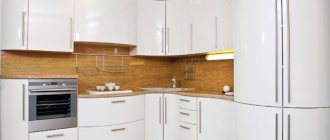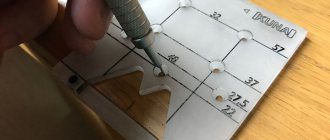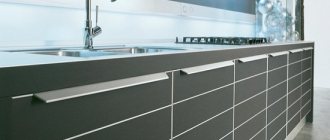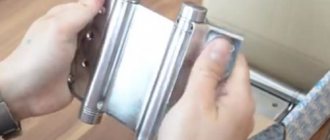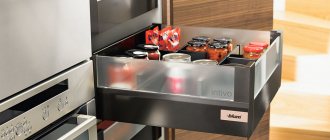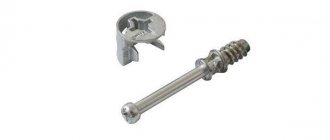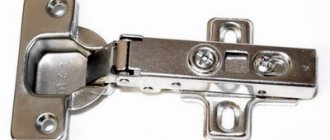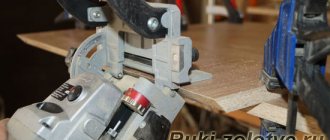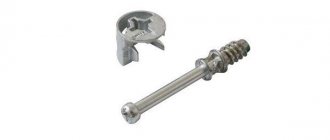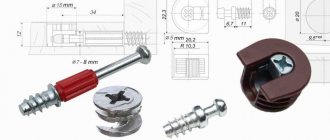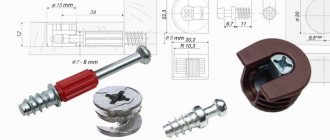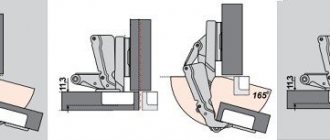Corner furniture hinges
Door hinges are the main element of furniture cabinets of any size and any purpose. They come in various types, differing from each other in design features and purpose.
The most popular are the four-joint ones because they are durable and last a long time. They are divided into two types: straight (with an angle of 90 degrees) and angular (all other non-standard angles). Corner furniture hinges are used in sets when assembling corner cabinets.
- How to choose the right ones?
- What types of corner hinges are there?
- Negative angle
- Corner hinge design
- How to choose suitable corner hinges?
- How to install correctly?
What types of corner hinges are there?
- overhead (internal), fixed inside the cabinet;
- overheads located on the facade and covering the side of the body when open.
- 30 degrees
- 45 degrees
- 120-135 degrees
Such hinges are mainly required in chamfered end corners where a wider opening is not possible. It is installed at an angle of 120 degrees, which is why it is sometimes marketed as “Grasshopper”.
Such furniture hinges are needed for trapezoidal cabinets. They are mounted at an angle of 135 degrees (there is a marking “135 degrees”).
Typically, such a furniture corner hinge connects two facades fastened together.
Negative angle
Such loops are difficult to find in stores because they are in little demand. They are used on end cabinets on the outer door, which is more convenient to open from the opposite side. But sometimes the only suitable option is just such a furniture hinge.
These are the standard and most popular parameters for corner hinges. If necessary, the opening angle can be made to any size, but to do this you will have to contact specialists who make custom-made furniture hinges, indicating all the desired parameters (size, material, opening angle). The downside to this is the higher price compared to buying traditional corner hinge options in a store.
Corner hinge design
These hinges have adjusting bolts, with which you can align the door on any side and along the angle of the rebate. They have a closer, thanks to which the door closes smoothly. This increases service life due to the fact that the mechanism wears out more slowly than if the sash were to slam shut abruptly.
How to choose suitable corner hinges?
Corner hinges come in standard varieties, but if necessary, any other opening angle can be made to order. The main selection parameter is the location of the cabinet relative to others and the available space for opening it.
Traditionally, furniture doors are opened by a closer at an angle of 90-110 degrees; in these cases, straight hinges are used. When it is necessary to go beyond this range, corner hinges are required. If the desired angle is wider, then you need to look for options marked “plus”; if narrower, then “minus”. If the non-standard angle is not a multiple of 5, then along with the hinge you will have to install a special pad to help adjust the angle.
Hinge installation angles
The installation angle is the angle between the door and the side wall of the furniture box when closed. Typically the installation angle is 90°. Standard angles in hinge production are 90 degrees, but there are plus 30° and plus 45°, as well as minus 30° and minus 40 degrees.
But when making furniture or assembly errors, it is necessary to correct the standard installation angle. For this purpose, adjustable and non-adjustable pads are used. Non-adjustable pads are made of plastic with minus or plus 5 degrees. By placing loops on the side wall under the striker plate, you can adjust the angle plus or minus; you can place two or even three such pads. But if you need to adjust to an angle that is not a multiple of 5, then this lining will no longer be suitable.
How to install correctly?
The Pythagorean goniometer is an auxiliary scale designed for calculations in preparation for installing corner furniture hinges. You can buy it at a specialty store or make it yourself using thick cardboard. Otherwise, you will have to measure everything yourself.
The flat side of the protractor must be leaned against the place where the hinge will be located and mark the place where it will rest against the lower part of the body from below.
First you need to install the hinge on the door, and place the striker on the wall. This is done on the basis of preliminary marking, during which the installation point of the loop is indicated. All you need is a ruler and a simple pencil. Having determined a suitable location, you should drill a hole to secure the cup. Its size will be equal to the thickness of the loop. Usually it is 11-13 mm.
Then you need to determine where the hinged element will be attached. To do this, install the loop in a pre-drilled hole and mark with a pencil the points where the fasteners are located.
It is better to use a template, and then you will not have to waste time making a separate calculation for each loop.
Using a drill corresponding to the size of the fastening elements, you need to make holes for the fastenings, after which you should install the hinged part of the hinge and secure it to the facade.
The next step is to determine the location of the strike plate. The cabinet door must be leaned evenly against the body and the corresponding point must be marked. It is important to remember that if there is any inaccuracy or mismatch, the hinge will not be installed correctly and the door will not be able to open and close.
A hole is also drilled at the marked point where the strike plate is secured.
The last step is to adjust the opening angle, if necessary.
The installation of corner furniture hinges is similar to the installation of straight hinges, with the exception of the need to additionally take into account the opening angle.
Kitchen cabinet hinges
The opening mechanism of x cabinets is the most vulnerable point in the design of kitchen furniture. Therefore, choosing reliable and durable hinges is no less important than choosing other high-quality materials for the kitchen.
What kind of hinges are needed for kitchen cabinets? The choice depends on their purpose, method of fastening and design.
A furniture hinge is attached to the body and door, which serves as a means of connecting two structural parts and as a mechanism for free opening/closing at a specific angle.
You can see the types discussed below in an accessible, understandable and visual way in the video review:
- How to choose coffee sets for the garden?
Features of purchasing custom-made kitchen furniture
- Choosing the perfect sofa
How to install furniture hinges
The bowl deserves the most attention in the hinge design. From the picture it is clear that it should literally be inserted into the surface. To do this, you need a hole (roughly speaking, an unfinished, not through hole), and a very respectable diameter. It is impossible to make such a hole with a regular drill; you will have to use a special cutter with a standard diameter of 35 mm, but there are other 25-32 mm mounting holes.
Forstner drill with height adjustment There are different types of drill cutters
The illustration shows two cutters, a standard one and a slightly modified one. It's useful to have both. It is better to start cutting a hole with a regular cutter, but then it will be best to change it to a modified one. The reason is that a standard cutter has a protruding tooth. Beginners may inadvertently drill a through hole with a cutter instead of a hole, and the tooth on the cutter greatly contributes to this.
The hinges must be installed so as to support the door securely and without distortion. Therefore, when attaching furniture hinges, it is important to mark the surfaces of the cabinet and door as accurately as possible, marking the places for cutting holes for hinge bowls and for screwing in self-tapping screws.
What types of hinges are there for kitchen cabinets?
Among the entire range of designs
There are only 2 types.
- Hinged (piano and card). These were the very first to appear; they were used back in the last century, but are practically not used in modern headsets. But when assembling antique retro or vintage furniture, they may just be needed.
- Four-jointed. Their design differs from previous conventional ones in that they can be adjusted in several places, ensuring free opening/closing of doors.
Four-hinged design device
Hinges according to door position and fastening method
The semi-overlay allows only partially covering the body of the furniture set. It has a slight bend that creates a gap between the sashes, which allows you to open two adjacent sashes at the same time. Used in intersectional fastenings of kitchen furniture, for example in a three- or two-door cabinet;
- overhead (external) are a hinge mechanism that allows the doors to open 900, actually 105 degrees.
They are most often used for fastening doors in kitchen units. They allow the doors of cabinets and sections to be tightly closed, covering the body on both sides, and serve for a long time without breakdowns;
Note! How to make a folding table with your own hands?
- internal (inset).
They have a large bend, which helps to move the inset door outside the body when opening. Rarely used for attaching heavy doors to chipboard cabinets. They allow you to sort of recess the doors when closed behind the cabinet body;
- Upholstered furniture in Perm
Beds with soft panels at the head: stylish solution and comfort
- Ideas for arranging furniture in a small room
- adit (straight)
are designed for attaching the front part to the sidewall of false panels.
Often used in corner sink cabinets.
Corner
For installation in corner floor and wall cabinets, hinges are needed that allow the doors to be opened at different angles.
Hinges depending on the opening angle and purpose in the table:
in sloping end cabinets
Carousel (inverse) loops deserve special attention
. Thanks to their design, they allow doors to open up to 180 degrees.
They are not used so often in corner cabinets.
- Is it possible to place a bed opposite the door?
- How to sell furniture active sales?
- Adhesive paper for furniture
For cabinets with vertical opening
These are mezzanine loops. Their main element is a spring, they are installed on the doors of hanging cabinets with a vertical opening.
For glass doors
Depending on the material on which they are installed, we can separately distinguish those that are mounted on glass surfaces. Their main difference is the presence of a special decorative lining that masks the loop. True, at home it is quite difficult to drill a hole for them.
Hinges for glass doors are also divided according to the opening method, angle, etc.
Hinges can be equipped with additional elements - closers. Closers can be built-in or come separately as a set.
With door closer
How many hinges do you need to buy to securely install the door?
To install hinges on doors yourself, first of all, you need to determine the required number of devices. It depends on the dimensions and weight of the door being hung, as well as the material from which it is made.
How many pieces do you need to buy depending on the weight and height of the facade?
In order for the hinges to fully cope with their assigned task - to ensure the free opening/closing of doors without creaking or moving, they must be installed correctly. Usually, instructions are always attached to the product.
The video will also help you understand the installation principle:
How to choose the right one
To choose the right accessories, there are a few things to consider. First of all, pay attention to what material they will be made of. Depending on this, several groups can be distinguished:
- products that are suitable for chipboard or MDF fibreboards,
- elements that can be mounted on the glass door,
- parts for attaching to a metal profile.
The modern hardware market is represented by a huge assortment of hinges for fastening doors.
When it comes to making a cabinet in the corner, you need to understand at what angle the facade will be installed in order to select the right fasteners.
Installing overlay door hinges on kitchen cabinets is a simple process. But still it requires little knowledge and skills.
Important! We take into account the dimensions and weight of the front panel in advance. It may be worthwhile to provide more hinge mechanisms or purchase reinforced models.
How to choose corner hinges
To select corner hinges for furniture doors, you need to determine:
- type of loop;
- required opening angle.
Types of loops
Corner hinges for furniture can be:
- internal or inset, installed when the door front is located inside the cabinet;
Furniture hinge for the door located inside the cabinet
Furniture hinge for external cabinet door
All types of corner-type furniture hinges have a number of features:
- allow adjustment in three main directions. To do this, special adjustment bolts are installed on each hinge, by rotating which you can align the cabinet door vertically, horizontally and set the optimal rebate size;
How to adjust hinges after installation
Furniture hinges, complemented by a built-in closer
Determining the opening angle
The standard opening angle for furniture hinges is considered to be 95º-110º. If it is necessary to increase or decrease the opening angle of the cabinet door, then the installation of corner furniture hinges is required.
Each corner loop is marked with the sign:
- plus if the opening angle exceeds the standard. For example, an angular hinge 45+ means that the door can be opened to 135º;
- minus if, with the hinge installed, the door opens at an angle of less than 90º. For example, a -45 hinge helps the door open 45º.
Device for determining the angle of a furniture hinge
To determine which hinge is required to install corner cabinet doors, use a special scale called a Pythagorean protractor.
The principle of working with the scale is extremely simple:
- the flat part of the protractor is attached to the cabinet box on the side where the hinge is supposed to be installed;
- The scale on the tool will tell you at what angle you need to purchase the loop. In this case, the optimal angle value will be located level with the lower side part of the cabinet box.
Determining the angle of a loop using a Pythagorean protractor
How to install hinges
The corner furniture hinge consists of:
- hinges equipped with a cup and housings with an installation groove;
- strike plate.
Elements that make up a corner furniture hinge
Installation of corner hinges is carried out according to the following scheme:
- Marking. First of all, the location of the hinge on the door is determined. The optimal distance is considered to be 70-120 mm from the edges of the facade. Using a pencil and ruler, mark the area for installing the hinge cup. The distance from the center of the cup to the edge of the door should be 20-22 mm.
Determining the location of furniture hinge cups
- Using a drill and a special attachment, a hole is drilled for the cup. The depth of the groove should correspond to the thickness of the loop. Most often, it is enough to make a hole 12.5 mm deep.
Preparing the hole for installing the hinge cup
- At the next stage, it is necessary to determine the location of the fastening elements of the hinged part of the loop. To do this, the loop is installed in the prepared hole and the locations of the fasteners are marked with a pencil.
Determining the location of the mounting bolts
Devices to facilitate marking when installing furniture hinges
- Using a drill with a drill that maximally matches the diameter of the fastening bolts, holes for fastening are drilled.
- The hinged part of the hinge is installed and attached to the door facade.
Fixing the hinged part of a furniture hinge
- Next, mark the installation location of the striker plate. To carry out this operation, you need to place the cabinet door against the frame and align its position. Using a pencil, mark the attachment points of the striker plate.
- The marked holes are drilled.
- The striker plate is being attached.
Installation of the strike plate on the cabinet frame
- If necessary, final adjustments are made.
The process of installing a furniture hinge is presented in the video.
The main aspect when choosing a corner hinge is to correctly determine the required opening angle. You can take measurements using a Pythagorean protractor, which is either purchased in a store or simply printed on thick paper. Installation of a corner hinge does not differ from the installation diagram of other types of furniture hinges.
Installation of furniture hinges
In order to secure everything efficiently and quickly, it is better to immediately take care of the tools that we will use. The master should have the following things at hand:
- screwdriver,
- end mill 35mm,
- pencil, measuring instruments (tape measure or ruler, protractor),
- awl,
- screwdriver and screws.
Traditionally, to arrange a cabinet in the corner, the same auxiliary materials are used as for other types of products. The opening level in this case will be less than 90º, so you should choose products marked “minus”.
When installing hinges, it is recommended to take the advice of specialists.
45 degree installation rule
The procedure for attaching fasteners is a standard procedure consisting of certain stages. But when it comes to equipping a cabinet in the corner, there are some nuances. When selecting a hinge for a corner cabinet, you must follow the 45-degree installation rule. To do this, it is better to take a Pythagorean goniometer - an auxiliary measuring device. With its help, you can accurately determine the closing angle, which will help tightly fix all the mechanisms.
It is advisable to use these fasteners for lightweight cabinets for small kitchens.
Additional Information. You can purchase a ready-made protractor at a specialized store, or you can make it yourself using a piece of thick cardboard.
The corner structure consists of several parts:
- A hinge that is attached to the door leaf. It includes a bowl, a shoulder (body), and an installation groove.
- Installation platform (mounting plate) designed for placement on the main box.
This work consists of a sequence of simple steps:
- Measuring and marking the door leaf.
- Drilling holes in the movable panel for screws and bowl.
- Attaching the hinged part to the façade sash.
- Marking and making holes in the housing to accommodate the striker plate.
- Attaching the strike plate to the cabinet.
- Adjusting the result.
Such actions are standard for connecting various types of components.
How to make a hole for fastening
To make suitable holes for fittings, you need to carefully measure and mark everything from the very beginning. The quality of the result directly depends on how accurate the marking is. We carefully ensure that the location of the hinge does not coincide with the internal shelves.
In order to embed the hinge into the door, you need to drill a hole.
After making pencil marks on the moving surface, we begin drilling holes. We start by making a recess for the bowl. Its depth, as a rule, is 12-13 mm. You should not drill a niche deeper, since the master cannot always be sure of the quality of the material from which the door is made.
Using a drill that is the most suitable in diameter, holes are made for the screws.
Important! Working with a cutter is not an easy task. If you have no experience, then it is better to first try to do it on a rough draft. Any scrap piece of wood board will do for training.
How to attach hinges to furniture doors
Once everything is prepared, you can attach the components. All parts are inserted into the grooves, leveled using a building level, and fixed with screws. They should be screwed as tightly as possible so that everything holds securely. The installation process is complete. Now it's time to start attaching the front part to the body.
When you begin to attach the door, it must be placed 2 mm lower and 1 mm to the side from the edge, so that the façade can be easily adjusted later.
Having carefully studied the issue, you can select the most effective components for furniture. Even a beginner can install them by following the instructions. In order to attach the fittings yourself, you do not need expensive equipment or professional skills. It is enough to carefully read this article and prepare in advance everything you need for work.
To avoid making a mistake with your choice, purchase kitchen fittings only from well-known manufacturers. In this case, it will serve you for a long time, without requiring replacement or special adjustments.
Types and selection of corner hinges
- Kinds
- Opening angles
- How to choose?
Door hinges are considered the basic elements of furniture fittings for any purpose; they can have a variety of different designs. The most popular on the market are four-joint products - practical and reliable, with a long service life. They, in turn, are divided into two types: straight lines with an angle of 90° and additional angular ones, which assume all other non-standard angles. Such fittings have become widespread when assembling corner furniture modules.
Corner hinges are used to place the doors of hanging furniture structures - most often these are corner wardrobe cabinets and kitchen units. Such loops can differ in opening angles, and the angle has not only a numerical value, but also a certain shape (sharp and obtuse).
Corner hinges have adjusting bolts that allow you to align the sash on any side, as well as along the angle of the rebate. They have a built-in closer, which makes opening the door as smooth as possible. This design significantly increases the service life due to the fact that the mechanism wears out much more slowly than when the sash is suddenly slammed shut.
Note! Light walnut furniture color
Corner hinges are:
- internal - such fittings are fixed inside the wardrobe;
- overhead - they are placed on the facade and cover the side of the body when open.
Fittings with a closer are classified depending on the type of facade, as well as the installation angle relative to the body. Visually, they differ from standard ones only in the configuration of the shoulder, inside of which special shock-absorbing mechanisms are mounted. Depending on the type of product, the door closer can be built-in or overhead. For example, such hinges are offered on the market by Blum.
However, in the vast majority of cases, the models sold in stores do not provide for the possibility of their further improvement. Therefore, if you plan to install facades with soft closing without knocking, then it is better to immediately purchase hinge mechanisms with closers. Of course, they will cost a little more, but they will also last longer.
A separate category of corner hinges are models created specifically for use in glass facades - they can be with or without drilling glass.
In general, all produced mechanisms may differ from each other according to the following criteria:
- size;
- metal manufacturing;
- base material where the hinges are attached;
- detachable design;
- fixation methods;
- strength.
Proper furniture maintenance
To ensure long-term and trouble-free operation of furniture canopies, it is not enough just to install and adjust them. Proper operation and regular lubrication are also important.
Following these recommendations will help maximize the life of your hinges:
- Frequency of adjustment. The first time setting up the canopies is done after installing the furniture. The following adjustments are made depending on the intensity of use of the cabinets. In one case, this will have to be done 4 times a year, in another, once is enough. If distortions or other problems with the sashes are identified, there is no need to wait for scheduled maintenance; the identified violations must be corrected immediately.
- Lubrication. To reduce friction in the moving elements of door hardware, they require periodic lubrication. This is done once a year or if there are any extraneous noises, squeaks or difficulties when opening/closing the doors. For lubrication use machine oil of any type (synthetic or mineral). A few drops of special lubricant (for example, WD-40 or similar) is enough.
Opening angles
Corner fittings are installed on corner furniture. In this case, the leaves are attached to the base of the door frame at a given angle. Such hinges allow the doors to open at 30, 45, 90, 135, and 175 degrees. The following options are most widespread.
- Angled hinge at 30°. Fixed to the facade located at 90+30 degrees relative to the body. Mainly in demand in end cabinets of dressing rooms or in kitchen sets. The installation angle is 120°, so some manufacturers mark similar products by installation - they go on sale under the name “120 degree loop”. Popularly, these models are better known as “grasshopper”.
- 45° corner hinge. Used in single and double door wardrobes. As a rule, furniture of this type is present in dressing rooms and kitchens. It is fixed at an angle of 135°, which is why it is labeled by some manufacturers as a “135 degree hinge.”
- Angled loop 120-130°. Found application when connecting pairs of facades connected to each other at an angle of 270°. This type of hinge opens like an accordion.
- It is less common to see hinges with a negative angle at points of sale. They are not widely used on the market; they are used mainly on the outer door of the end cabinet, which is easier to swing open from the opposite edge. There are situations when such a loop becomes the only available option.
The listed types of corner hinges belong to the category of standard and most common. If necessary, you can set any other opening angle, for example, 60, 15 or 25 degrees. In this case, you will have to contact the craftsmen who make these to order. They will make fittings taking into account the customer’s data: size, desired opening angle and material. The disadvantages of this solution are the relatively high cost and time spent on producing the optimal model.
How to choose?
When purchasing corner hinges, the basic selection criterion is the angle of the cabinet relative to other pieces of furniture, as well as the free space available for swinging it open. Most often, furniture doors are opened using a closer at an angle of 90 to 110 degrees. In this case, straight loops are used. Angular ones are needed when you need to go beyond the specified range.
If the opening angle of the sash is greater, you should choose a product marked “plus”; if the angle is lower, then, accordingly, “minus”. In a situation where the non-standard angle is not a multiple of five, it is necessary to additionally mount a special attachment that will allow you to adjust the optimal opening angle.
The following video talks about hinges for furniture assembly.
Types of furniture hinges by design
There are many hinges and canopies used to attach a swing door to the frame of a cabinet or cabinet. Basically, in modern furniture production, four-hinged hinges , which allow the facade to be adjusted in three planes at once:
- higher lower,
- left/right,
- to/from the facade.
All of them consist of two interconnected parts - a bowl with an elbow and a strike plate . Often the strike plate is called a mounting or mounting plate. This article will focus specifically on four-hinged hinges.
Other types of furniture hinges can be combined into one large group as “bowlless” hinges.
piano hinges, card hinges, pin hinges, and heel hinges, known to everyone for fastening interior doors and facades in old furniture . They are rarely used in modern furniture. For example, piano, card and mortise hinges can be used to attach tabletops to the base, movable legs in book-tables. For ordinary cabinets, brass decorative hinges are used as additional decor.
Overhead hinges that do not require drilling of the facade . They come in handy when the thickness of the material chosen for the facade does not allow installing (embedding) a four-hinged hinge due to the depth of the bowl. The only drawback of such hinges is their rigid fastening, which does not allow adjustment in three planes, like four-hinge hinges.
Hinges for fastening specific facades . For example, prefabricated facades made of aluminum frames of different widths are installed on special hinges - you can purchase them together with the profile. Please note that, just like regular four-hinged hinges, they can be overhead or internal, designed for corner cabinets of 45, 135, 180 degrees and facades covering the end of the case.
What is a four-hinge furniture hinge for cabinets
With very rare exceptions, all modern cabinet furniture, including kitchen cabinets and cabinets, are equipped with so-called four-hinge furniture hinges. They are also called “cup”, since installation requires making a hole in the facade in the shape of a “bowl”.
A little history
The four-hinged furniture hinge for cabinets was invented before World War II by the Italian craftsman Salice. Its peculiarity is that the opening mechanism allows the door to rotate and move to the center of the body without going beyond its dimensions. And at the same time it makes it possible to adjust the position of the doors in depth, height and width of the product. All modern furniture hinges are in one way or another developed based on the Salice principle. Moreover, each manufacturer has dozens of varieties of positions.
Diagram of a four-hinged hinge, the principle of installation and adjustment with your own hands
A furniture canopy of this type consists of three parts: a cup, a base and a counter strip.
The canopy is based on a body with a mechanism consisting of two “levers”. One side of each “lever” is rigidly fixed to the body using a hinge, the second side holds the hinge bowl.
The hinge cup is installed in a drilled hole in the facade made from the inside. The strike plate is attached to the inner side of the cabinet or cabinet body. Connect the hinge body with the cup and the strike plate using a screw. The position of the furniture hinge body is adjusted using a screw installed on the body. It rests against the strike plate or fits into an existing groove.
Features of loop design
Each manufacturer of furniture fittings tries to somehow specially design their products and make them recognizable. For example, many brands complete awnings with decorative plastic or metal overlays with brand logos. With their help, you can close the fastening screws, which will give the product a more laconic and attractive appearance.
Someone produces furniture hinges in an interesting design. Or even in another metal like “gold”, “brass”, with a black or white coating.
It is worth understanding that the differences of this kind are purely visual. But you should still choose furniture hinges for cabinets based on the performance characteristics of the opening mechanism itself, to ensure long and uninterrupted service.
Manufacturers of quality furniture hinges
Leading manufacturers of kitchen sets and other cabinet furniture, who care about their reputation and are ready to bear warranty obligations, equip their products with components from generally recognized leaders in the global furniture accessories market. Furniture hinges are, in fact, the main opening mechanism and they are presented in the line of almost every well-known manufacturer.
Depending on your budget, we recommend paying attention to the range of brands:
- Blum, Mepla-Alfit, Grass (Austria).
- Hettich, Hetal Huwil, Kessebohmer (Germany).
- Salice, Effegi Bretti, Ferrari (Italy).
Furniture hinges for cabinets from domestic brands, Boyard and Leroy Merlin, are also widely used on the Russian market. They are somewhat inferior in quality and variety of assortment to European brands, but, judging by the reviews, they “show themselves” quite well in long-term use and are at the same time affordable.
Types of four-hinged furniture hinges
According to the design, according to the way the bowl with the knee is attached to the striker, four-hinge furniture hinges can be of three types:
- Slide-on—the parts of the loop are inserted into each other and connected using a fixing screw that has special notches, thanks to which it reliably “holds” the connection even in a weakened state. This type of loop is the most common.
- Clip-on - the parts of the loop are connected by simple snapping, without screws. The facade can be removed and installed without using any tools - just pull the latch. Clip-on hinges are also called quick-installation hinges.
- Key-hole – on the shoulder of the bowl with a knee there is a hole resembling a key hole in shape - a keyhole. The arm and bar are secured by passing the head of the fixing screw through this hole.
Regardless of the design, all of the above types are divided according to their purpose and installation method - what facade is used in the furniture and how it is attached to the body.
90 degree hinges
*The designation 90 degrees in this case is conditional, it is used to mark hinges that open at a right angle. In fact, the door travel is somewhat greater, reaching about 105-120 degrees when opening. Some manufacturers and sellers of accessories may label this type not “loop 90”, but, for example, “loop 110” - there is no mistake here.
The 90 degree overhead (external) loop has a straight “shoulder”, without bending. Used for facades that completely cover the ends of the side walls of the body (without taking into account the technological gap, which can be 1-5 mm).
Half-overlay (middle, half-outer) loop 90 degrees , the shoulder of the bowl with the knee can be distinguished by a medium bend. Rarely used. For example, in kitchen two-row horizontal cabinets for attaching the bottom door and in three-leaf wardrobes for attaching the middle facade.
The 90-degree inset (internal) hinge is distinguished by a large bend on the “shoulder”, due to which the inset door is carried out when opened outside the body. Rarely used. For example, in office furniture, in which the body is made of thickened 22 mm chipboard and the internal facade emphasizes this detail.
180 degree hinges
A straight (gauge) hinge for false panels is designed for attaching the facade to the sidewall, which is located in the same plane. Most often used in corner kitchens, when using the appropriate corner sink module.
The 165-degree carousel (crab, crocodile, transformer) hinge is recognizable by the characteristic complex shape of the bowl's elbow, which ensures that the door opens completely relative to the body - almost up to 180 degrees. It can also be invoice, semi-invoice and inlay. Differs in the shape of the shoulder.
Types of corner hinges
A 30-degree corner hinge “presses” the façade, located at an angle of 90+30 degrees relative to the body. It is most often used in beveled end cabinets of kitchen units or wardrobes. Installation angle – 120 degrees. Some manufacturers mark it by installation angle, i.e. called a 120 degree loop.
The 45 degree corner hinge is used in trapezoidal single and double door cabinets - for example, kitchen or dressing rooms. Similar to the previous type, it can be called by the angle of installation - a 135 degree loop.
An angular loop of 120-135 degrees most often serves as a connection between two facades, fastened together at a right angle of 270 degrees, which come off like an accordion. In this case, the door without a handle is attached to the body using a carousel hinge from the previous category.
Corner hinges with a negative opening angle are used extremely rarely, due to design features: end cabinets, as a rule, serve as the end of a row of furniture and it is more convenient to open the door from the other side. But there are projects in which it is more expedient to implement the opposite solution.
The photo shows the main types of standard furniture hinges, without closers , ensuring smooth closing. Hinges with closers are classified similarly - depending on the type of facade and the installation angle relative to the body. They differ in appearance from standard ones only in the shape of the shoulder, inside of which a special movement-absorbing mechanism is built. Also, the closer may not be built-in, but overhead - as, for example, a manufacturer such as Blum offers. But the bulk of offers on the market still do not imply the possibility of improvement. Therefore, if you are determined to install facades with soft closing, without annoying knocking, purchase fittings with closers right away. True, it costs a little more. Before purchasing, I recommend that you read the review on furniture hinges with closers.
A separate group of furniture hinges is for glass facades, with and without drilling glass. Review on glass hinges here.
Types of furniture hinges
Nowadays, on store shelves, consumers encounter a wide range of products in this area. Mounts may vary in:
- structural features,
- installation method,
- intended purpose.
The fittings create a certain style.
Thanks to it, the design level of any household item is determined. By paying attention to such points, you can choose the most functional options that satisfy a specific request. Depending on the method of application to the base, the components have different names.
One of the most important parts of the fittings are the hinges.
Overhead and semi-invoice
One of the most common among specialists are overhead four-hinged structures. This option is used when the door completely covers the walls of the box on which it is installed. It is popular for installation on any furniture: kitchen, dressing room, office. The product makes it possible to completely close the cabinet by tightly pressing the movable front panels to the base.
The mechanism allows you to open the door 90 degrees. It also supports the sashes in the chosen position and prevents misalignment.
If the side of the niche is covered simultaneously by two door panels, semi-overlay parts are used. Their distinguishing feature is the bending of the base. Thanks to this feature, it is possible to obtain a small gap between the components of the facade placed on the same area.
Most often, this type of hinge is included in kitchen sets.
Inverse and piano
Inverse fastenings allow opening 180º, forming a single line with the side of the box. Such components are most often used to equip built-in spaces.
This option is used for bedside tables and cabinets. It allows you to securely fasten the side part.
The piano mechanism is an obsolete type of product. It is very simple and understandable even to an inexperienced master, but still cannot boast of reliability. The design consists of two identical metal strips connected by steel wire in the middle. Most often this type is found on samples from past years. But sometimes it is still used today, for example, in making a kitchen corner with folding seats.
This view is considered obsolete. That is why it is rarely used and included in modern designs.
Internal and corner
The internal structure is taken when it is necessary to place doors inside a niche. That is, the sash does not overlap the ends of the walls, but is located directly between them inside.
The hinge is often included in pencil cases and cabinets that have heavy doors.
In most cases, it is necessary to provide a rectangular opening. But sometimes you need to attach the facade at an angle that differs from the standard by several degrees in one direction or another. In this case, special fasteners are used, which are marked accordingly:
- “plus” if an opening with a value above 110º is expected;
- “minus” when the opening level is below 90º.
Most often, such hinges are purchased for corner cabinets.
The hinge accepts any angle and provides the system with the necessary strength. It is also possible to supplement the system with closers.
Note! Products in this group on the market have a pitch of 5º. If the obtained value is not a multiple of this indicator, then additional overlays are used. These devices allow you to set the correct parameters yourself.
Card loops
Representatives of this group are in many ways reminiscent of their piano counterparts. It also consists of two metal plates that are connected by one hinge. Most often, this thing is used in furniture design to give things an antique effect. Card elements are often made in the form of various figures with wavy, rounded or pointed edges.
With its help, retro-style interior items are most often added.
Gallery and card shops
The adit components allow you to attach the sash not to the sidewall, but to the blank wall of the cabinet located in front. Often this type of accessory is also called “blind” because they attach the door to the adjacent false panel.
If the fittings are of high quality, then with its help it will be possible to secure a door of any weight and size.
Card auxiliary ones are used to attach folding elements. This part is installed on the cabinet from the ends, which makes it possible to move the sash 180º.
The holder can also be used as part of folding parts of furniture.
Furniture hinges for cabinet doors: how to choose a model with a 45, 60 and 90 degree closer
In modern production, a large number of accessories are used. In this article we will look at furniture hinges for cabinets. These are mechanical devices for opening and closing swing doors. There are many different models sold in stores, and before purchasing, it is advisable to know which option will suit your facades. We will tell you about the design and installation features of canopies.
Types of loops by design
They are hinge units that connect the doors to the cabinet body. Various design solutions make it possible to leave the door leaf open at a certain angle. Based on the method of fastening facades, you can choose the following models:
- Four-jointed.
- Mezzanine.
- Pianos.
- For glass doors.
Quadruple joint
The most common and popular are 4-hinge furniture hinges. They are distinguished by their versatility and high reliability. There are three types of four-hinged hinges, which differ from each other in the method of fastening the shoulder cup to the striker:
Slide-on. The protruding part of the strike plate fits into the shoulder. Fastening is carried out with a fixing screw. The connection has notches on both sides. The length of the arm can be lengthened or shortened by securing the connection with notches.
Clip-on. This system allows you to do without a screw. The parts of the loop are connected by a latch. Such canopies are called quick installation models. The cabinet door can be removed and replaced without tools.
Key-hole. The cup arm is placed with a hole on the counter plate screw. The edges of the opening are inserted under the screw. The mounting hole resembles a keyhole.
Their varieties are used depending on the position of the closed door relative to the wall of the cabinet body. There are the following four-hinged types:
- invoice;
- semi-invoice;
- loose-leaf;
- corner;
- inverse;
- adit.
Invoice
When the door is closed, the hinge fits tightly onto the end of the side wall of the cabinet. They are mainly used en masse in rectangular designs of kitchen furniture. The loop consists of a cup with a shoulder and a striker plate. How both parts are connected can be seen in the figure.
Overhead rotary hinges are installed in bedroom and living room closets, bedside tables and chests of drawers. The mechanisms ensure a tight fit of the doors to the entire perimeter of the furniture opening.
There are overhead mechanisms that do not require deep excavation in the facade mass. They are used when the thickness of the door leaf does not allow making a full recess for the cup. The hinges are fastened without insertion only with screws.
Half waybill
Such designs are used when hanging doors on one wall on both sides. They are placed in wardrobes of several sections, separated by partitions, so that adjacent facades do not interfere with each other when opened. For this purpose, the shoulder is made with a slight bend. The part allows you to maintain dimensions between open sashes of 5 - 10 mm.
Insert
The internal or inset design is designed so that when the door is closed, its facade becomes inside the cabinet opening at the same level as the end of the side panel. The minimum opening angle for the door leaf is 90 degrees.
Unlike previous models, the shoulder of the inset design is more curved. The installation of inset hinges is no different from the installation of other 4-hinged models.
Corner
You should install hinges for corner kitchen cabinets where you want to hang the doors at a certain angle to the side of the cabinet. Various models are designed for installation angles of the facade in relation to the side of the body of 30, 45, 90, 135 and 180 degrees.
Select a corner hinge model using the following table:
| Closed façade corner | Cabinet design |
| 30 - 60 degrees | Beveled end housing |
| At 45 degrees | Trapezoidal body |
| 120 – 135 degrees | Two facades opening with an accordion |
Inverse
Carousel or inverse hinges (crocodile, crab, transformer) are designed to open cabinet doors almost 180 degrees. The open façade is in line with the plane of the load-bearing part of the body. The complex shape of the shoulder allows the door to rotate completely 165 degrees. The transforming loop can be of overhead, semi-overlay and internal design.
Shtolnaya
The straight or adit model is secured with a counter strip to the false panel of the cabinet. The panel looks like an additional strip installed close to the sidewall. Wall hinges are usually installed in kitchen cabinets and corner cabinets under the sink.
All types of four-hinged models from companies such as the Austrian Blum (BLUM), the Spanish Amig (AMIG) and other equally well-known manufacturers are equipped with built-in or overhead door closers.
The device provides slow, soft closing of doors without knocking. To do this, you only need to push the door slightly and it will continue to move slowly until it closes completely. You can install a separate door closer next to a simple facade opening mechanism.
Let's discuss this article together:
Click to cancel reply.
Types of loops
All furniture hinges are semi-mechanical parts for opening and closing facades. Taking into account the purpose and installation method, they are divided into:
- internal
- semi-invoice
- invoices
- card
- piano
- inverse
- corner
- heel
- pendulum
- ombre
- gallery
- secretory
- mezzanine
Furniture fittings can also be made of different materials and differ in opening angle. There are many different mechanisms on the market, including those designed for furniture and interior doors. Having similarity in appearance and method of functioning, products can withstand different loads. Therefore, for interior doors, what is best can be suggested by the specialist who will carry out the installation.
